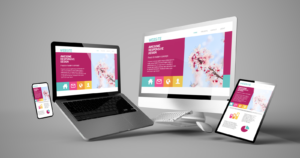Website Design and User Experience

1.0 Elements of a Successful Website
1.1 Clear Purpose
The primary goal of a website should be clearly defined, whether it
is to sell products, provide information, generate leads, or offer
services. A clear purpose helps to align content, design, and
functionality.
Conduct stakeholder interviews and market research to determine
what objectives the website needs to achieve. For example, an e-commerce site should focus on conversion rates and user-friendly
shopping experiences, while an informational site should prioritize
content clarity and accessibility.
1.2 Professional Design
Visual Appeal: A professional website design reflects the brand’s
identity and credibility. Use high-quality images, a consistent color
scheme, and modern typography to create a visually appealing site.
Brand Consistency: Ensure that design elements align with brand
guidelines. This includes using the company’s logo, color palette,
and font choices consistently throughout the website.
1.3 Responsive Design
Importance of Responsiveness: A responsive design ensures that
the website functions well on various devices, from desktops to
smartphones. This is crucial for providing a seamless user
experience and improving SEO.
Implementation: Use responsive web design techniques, such as
flexible grids, fluid images, and media queries, to adapt the layout
based on screen size. Test the website on multiple devices and screen
resolutions to ensure compatibility.
1.4 Content Quality
Relevance and Value: Content should be relevant to the target
audience and provide value. This includes clear, concise, and
engaging text, as well as well-organized information.
Content Structure: Use headings, bullet points, and concise
paragraphs to make content easy to scan and read. Incorporate visual
elements such as images, videos, and infographics to enhance
content engagement.
1.5 Load Speed
Impact on User Experience: Fast loading times are essential for
retaining visitors and reducing bounce rates. Slow websites can
frustrate users and negatively impact search engine rankings.
Optimization Techniques: Optimize images and media files,
leverage browser caching, and use Content Delivery Networks
(CDNs) to improve load times. Regularly test and monitor website
performance to identify and address speed issues.
1.6 Call-to-Action (CTA)
Purpose of CTAs: CTAs guide users toward desired actions, such as
making a purchase, signing up for a newsletter, or contacting the
business. Effective CTAs are crucial for achieving the website’s
goals.
Best Practices: Design CTAs to be prominent and compelling. Use
action-oriented language and ensure that CTAs stand out visually.
Place them strategically throughout the website to guide user
behavior.
2.0 Best Practices for Website Design and Navigation
2.1 Consistent Layout
Design Consistency: Maintain a uniform layout across all pages to
create a cohesive user experience. This includes consistent use of
colors, fonts, and design elements.
Navigation Consistency: Ensure that the navigation menu and other
interactive elements are positioned consistently throughout the site to
help users easily find information.
2.2 Intuitive Navigation
Menu Structure: Design navigation menus to be clear and logical.
Use descriptive labels for menu items and organize them into
categories and subcategories that reflect the website’s content
hierarchy.
User Flow: Consider the user’s journey and ensure that the
navigation supports easy access to key sections of the site.
Implement breadcrumb trails and clear pathways for users to follow.
2.3 Search Functionality
Search Bar Design: Include a prominent search bar on the website
to help users quickly find specific content or products.
Search Features: Implement autocomplete suggestions and filters to
enhance search functionality. Ensure that search results are relevant
and easy to navigate.
2.4 Visual Hierarchy
Element Placement: Arrange elements on the page to guide users
attention. Use headings, subheadings, and contrasting colors to
highlight important information.
Content Prioritization: Place the most critical information and
CTAs in prominent positions where users are likely to see them first.
2.5 Accessibility
Design for All Users: Ensure that the website is accessible to users
with disabilities by following web accessibility standards (e.g.,
WCAG). This includes providing alternative text for images,
ensuring keyboard navigability, and using sufficient color contrast.
Testing and Compliance: Regularly test the website for accessibility
issues and comply with relevant legal requirements and guidelines.
3.0 Enhancing User Experience (UX)
3.1 User Research
Conducting Research: Use methods such as surveys, interviews,
and usability testing to gather insights about user needs and
preferences. Analyze user behavior and feedback to inform design
decisions.
Implementing Findings: Apply research findings to improve
website design and functionality, ensuring that the site meets users’
expectations and addresses their pain points.
3.2 Personalization
Tailoring Content: Use data and analytics to personalize the user
experience. This can include personalized recommendations,
dynamic content, and targeted messaging based on user behavior and
preferences.
Privacy Considerations: Ensure that personalization efforts
comply with privacy regulations and respect users’ data security.
3.3 Interactive Elements
Engaging Features: Incorporate interactive elements such as
quizzes, polls, and forms to engage users and encourage interaction.
These features can provide valuable insights and enhance user
involvement.
User Feedback: Use interactive elements to collect user feedback
and suggestions, helping to continuously improve the website.
3.4 Feedback Mechanisms
Feedback Options: Provide users with easy ways to give feedback,
such as contact forms, chatbots, or survey links. Make it simple for
users to report issues or share their opinions.
Responding to Feedback: Address user feedback promptly and
make necessary improvements based on their suggestions.
Communicate changes and updates to users to show that their input
is valued.
3.5 Continuous Improvement
Ongoing Optimization: Regularly review website performance
metrics, user feedback, and industry trends to identify areas for
improvement. Implement updates and optimizations to enhance user
experience and meet evolving needs.
A/B Testing: Conduct A/B testing to evaluate different design
elements and features. Use the results to make data-driven decisions
and refine the website’s design and functionality.
